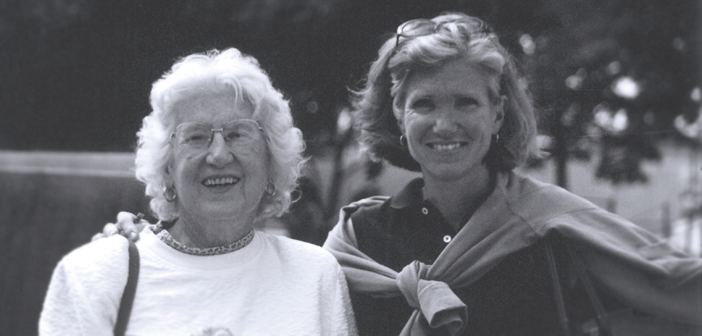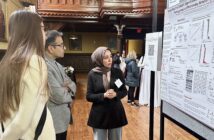Students celebrate the lives of anatomical gift donors.
Jacy Worth PMD ’11 waited almost two years to receive the ashes of her mother, Margaret Larkin Jusyk GPMD’11, but she took pride and comfort knowing that even after death her mother was still teaching and contributing to discovery.
Before she donated her body to Alpert Medical School’s Anatomical Gift Program, Peg Jusyk enjoyed a long and fruitful life. In World War II she served in the Navy, flying on planes as a WAVES aerographer to provide weather data and to instruct colleagues. The Connecticut native earned bachelor’s and master’s degrees at the University of Bridgeport and Fairfield University, worked as a teacher and a school psychologist, and assisted in pediatrics research at Yale. Between her degrees she worked on statistics for Dun & Bradstreet and mapping for Pan Am Airways.
Jusyk was a pastel artist, an avid golfer, and a church, museum, and community volunteer whose services included protecting endangered piping plovers and visiting the homebound elderly. She participated in the famed Women’s Health
Initiative medical study. After retirement, she earned a real estate license and continued working.
“She had a quest for knowledge her entire life,” Worth says. “She was always very interested in science and the progress
of science.”
To Worth, it didn’t seem surprising when Jusyk said she wanted to be an anatomy donor.
“I was sort of happy she was still working, still doing something,” Worth says. “I’m so proud of her. She was still useful. That’s how she always was.”
Worth and her husband, Jim, were among more than 40 family members of anatomical donors who gathered at Brown on an August evening at the invitation of the Alpert Medical School Class of 2017. These were the students who in the last year, because of the contributions of the donors, gained the rigorous and intimate knowledge of the human body’s structure and complexity that a medical education requires.
“Our group thought it was important to include the families because they made a sacrifice in their loved one donating their body,” says Samantha Roche MD’17, one of the organizers of the ceremony.
This is the first year that students, who had previously reflected on their anatomy lab experiences in private, decided to invite the families. “It’s important for us to thank them, too. As much as the donors donated their bodies, these families have been waiting for their remains for quite some time,” Roche says.
Worth, whose son Patrick graduated from the Medical School in 2011, says she’d often think of her mother during the two years her body was at Brown. She got her mother’s ashes back last spring—and soon after, an invitation to attend the ceremony.
Gratitude to the donors and their families was the theme of the evening, made possible by support from the Brown Medical Alumni Association. The lessons the students learn from the donated bodies are fundamental to their training as doctors and will forever influence the care they give to every patient they treat.
“Each medical student in this room will see thousands, if not tens of thousands, of patients in his or her medical career,” Allan Joseph MD’17 told the audience. “No matter what field we choose to pursue, we will rely on our anatomical knowledge in treating all of them. We would not have that knowledge without the Anatomical Gift Program. We medical students cannot thank the donors who gave such a gift to us, but we can thank their families and their friends for supporting them in that decision.”
Worth says Body of Work, a book by Christine Montross MD’06 MMS’07 RES’10 about her experiences in the anatomy lab, likely provided some of the inspiration for Jusyk to donate her body. Montross, now an assistant professor of psychiatry and human behavior, spoke at the ceremony and read from her book.
Norin Ansari ’12 MD’17, a co-organizer, says she reflected on the extraordinary gift of the donors when she viewed the “memory table” just outside the De Ciccio Family Auditorium in the Salomon Center for Teaching, where family members placed pictures and articles about the donors.
“To see a man smiling proudly in uniform, to read about a centenarian reaching her milestone birthday, and to see a proud grandmother with her grandson—all of these really put into perspective that these people were just like you and me. But they must have also been very generous and kind souls to want to continue to be so helpful even after death,” Ansari says. “Prior to this, we had only known their ages, occupations, and cause of death.”
At the end of the ceremony, which also included student musical performances and a blessing and poetry reading from University Chaplain Janet Cooper Nelson, students crossed the stage as Roche read the first name and last initial of each donor. As the students crossed, they placed a white alstroemeria in a vase for each name. Among those 43 names was “Margaret J.,” who, like all the donors, had provided a gift of education for the good of thousands.




